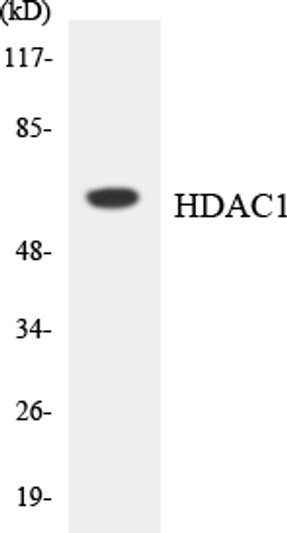| Host: | Rabbit |
| Applications: | WB/IHC/IF/ELISA |
| Reactivity: | Human/Mouse/Rat |
| Note: | STRICTLY FOR FURTHER SCIENTIFIC RESEARCH USE ONLY (RUO). MUST NOT TO BE USED IN DIAGNOSTIC OR THERAPEUTIC APPLICATIONS. |
| Short Description : | Rabbit polyclonal antibody anti-Histone deacetylase 1 (387-436 aa) is suitable for use in Western Blot, Immunohistochemistry, Immunofluorescence and ELISA research applications. |
| Clonality : | Polyclonal |
| Conjugation: | Unconjugated |
| Isotype: | IgG |
| Formulation: | Liquid in PBS containing 50% Glycerol, 0.5% BSA and 0.02% Sodium Azide. |
| Purification: | The antibody was affinity-purified from rabbit antiserum by affinity-chromatography using epitope-specific immunogen. |
| Concentration: | 1 mg/mL |
| Dilution Range: | WB 1:500-1:2000IHC 1:100-1:300ELISA 1:5000IF 1:50-200 |
| Storage Instruction: | Store at-20°C for up to 1 year from the date of receipt, and avoid repeat freeze-thaw cycles. |
| Gene Symbol: | HDAC1 |
| Gene ID: | 3065 |
| Uniprot ID: | HDAC1_HUMAN |
| Immunogen Region: | 387-436 aa |
| Specificity: | HDAC1 Polyclonal Antibody detects endogenous levels of HDAC1 protein. |
| Immunogen: | The antiserum was produced against synthesized peptide derived from the human HDAC1 at the amino acid range 387-436 |
| Post Translational Modifications | Sumoylated on Lys-444 and Lys-476.which promotes enzymatic activity. Desumoylated by SENP1. Phosphorylation on Ser-421 and Ser-423 promotes enzymatic activity and interactions with NuRD and SIN3 complexes. Phosphorylated by CDK5. Ubiquitinated by CHFR, leading to its degradation by the proteasome. Ubiquitinated by KCTD11, leading to proteasomal degradation. |
| Function | Histone deacetylase that catalyzes the deacetylation of lysine residues on the N-terminal part of the core histones (H2A, H2B, H3 and H4). Histone deacetylation gives a tag for epigenetic repression and plays an important role in transcriptional regulation, cell cycle progression and developmental events. Histone deacetylases act via the formation of large multiprotein complexes. Acts as a component of the histone deacetylase NuRD complex which participates in the remodeling of chromatin. As part of the SIN3B complex is recruited downstream of the constitutively active genes transcriptional start sites through interaction with histones and mitigates histone acetylation and RNA polymerase II progression within transcribed regions contributing to the regulation of transcription. Also functions as a deacetylase for non-histone targets, such as NR1D2, RELA, SP1, SP3, STAT3 and TSHZ3. Deacetylates SP proteins, SP1 and SP3, and regulates their function. Component of the BRG1-RB1-HDAC1 complex, which negatively regulates the CREST-mediated transcription in resting neurons. Upon calcium stimulation, HDAC1 is released from the complex and CREBBP is recruited, which facilitates transcriptional activation. Deacetylates TSHZ3 and regulates its transcriptional repressor activity. Deacetylates 'Lys-310' in RELA and thereby inhibits the transcriptional activity of NF-kappa-B. Deacetylates NR1D2 and abrogates the effect of KAT5-mediated relieving of NR1D2 transcription repression activity. Component of a RCOR/GFI/KDM1A/HDAC complex that suppresses, via histone deacetylase (HDAC) recruitment, a number of genes implicated in multilineage blood cell development. Involved in CIART-mediated transcriptional repression of the circadian transcriptional activator: CLOCK-BMAL1 heterodimer. Required for the transcriptional repression of circadian target genes, such as PER1, mediated by the large PER complex or CRY1 through histone deacetylation. In addition to protein deacetylase activity, also has protein-lysine deacylase activity: acts as a protein decrotonylase and delactylase by mediating decrotonylation ((2E)-butenoyl) and delactylation (lactoyl) of histones, respectively. |
| Protein Name | Histone Deacetylase 1Hd1Protein Deacetylase Hdac1Protein Deacylase Hdac1 |
| Database Links | Reactome: R-HSA-1362277Reactome: R-HSA-1362300Reactome: R-HSA-1538133Reactome: R-HSA-193670Reactome: R-HSA-201722Reactome: R-HSA-2122947Reactome: R-HSA-2173795Reactome: R-HSA-2173796Reactome: R-HSA-2644606Reactome: R-HSA-2894862Reactome: R-HSA-3214815Reactome: R-HSA-350054Reactome: R-HSA-3769402Reactome: R-HSA-427389Reactome: R-HSA-427413Reactome: R-HSA-4551638Reactome: R-HSA-4641265Reactome: R-HSA-6804758Reactome: R-HSA-69205Reactome: R-HSA-73762Reactome: R-HSA-8936459Reactome: R-HSA-8943724Reactome: R-HSA-9018519Reactome: R-HSA-9022538Reactome: R-HSA-9022692Reactome: R-HSA-9022699Reactome: R-HSA-9022702Reactome: R-HSA-9615017Reactome: R-HSA-9679191Reactome: R-HSA-9701898Reactome: R-HSA-9725371Reactome: R-HSA-9824594Reactome: R-HSA-9825892Reactome: R-HSA-983231Reactome: R-HSA-9843940Reactome: R-HSA-9844594Reactome: R-HSA-9845323Reactome: R-HSA-9856649 |
| Cellular Localisation | Nucleus |
| Alternative Antibody Names | Anti-Histone Deacetylase 1 antibodyAnti-Hd1 antibodyAnti-Protein Deacetylase Hdac1 antibodyAnti-Protein Deacylase Hdac1 antibodyAnti-HDAC1 antibodyAnti-RPD3L1 antibody |
Information sourced from Uniprot.org












